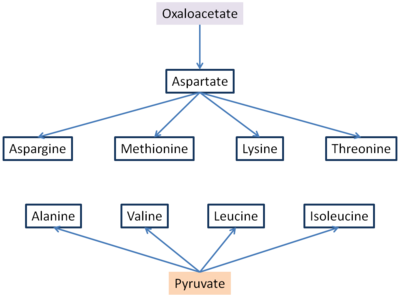Oxaloacetic acid

| |

| |
| Names | |
|---|---|
| Preferred IUPAC name
2-Oxobutanedioic acid | |
| Other names
Oxaloacetic acid
Oxalacetic acid 2-Oxosuccinic acid Ketosuccinic acid | |
| Identifiers | |
3D model (
JSmol ) |
|
| ChEBI | |
| ChemSpider | |
ECHA InfoCard
|
100.005.755 |
| EC Number |
|
IUPHAR/BPS |
|
| KEGG | |
PubChem CID
|
|
| UNII | |
CompTox Dashboard (EPA)
|
|
| |
| |
| Properties | |
| C4H4O5 | |
| Molar mass | 132.07 g/mol |
| Density | 1.6 g/cm3 |
| Melting point | 161 °C (322 °F; 434 K) |
| Thermochemistry | |
Std enthalpy of (ΔfH⦵298)formation |
-943.21 kJ/mol |
Std enthalpy of (ΔcH⦵298)combustion |
-1205.58 kJ/mol |
Except where otherwise noted, data are given for materials in their standard state (at 25 °C [77 °F], 100 kPa).
| |
Oxaloacetic acid (also known as oxalacetic acid or OAA) is a crystalline
Properties
Oxaloacetic acid undergoes successive deprotonations to give the dianion:
- HO2CC(O)CH2CO2H ⇌ −O2CC(O)CH2CO2H + H+, pKa = 2.22
- −O2CC(O)CH2CO2H ⇌ −O2CC(O)CH2CO2− + H+, pKa = 3.89
At high pH, the enolizable proton is ionized:
- −O2CC(O)CH2CO2− ⇌ −O2CC(O−)CHCO2− + H+, pKa = 13.03
The

Biosynthesis
Oxaloacetate forms in several ways in nature. A principal route is upon
It also arises from the condensation of
- CH3C(O)CO2− + HCO3− + ATP → −O2CCH2C(O)CO2− + ADP + Pi
Occurring in the
Oxaloacetate can also arise from trans- or de- amination of aspartic acid
Biochemical functions
Oxaloacetate is an intermediate of the
Gluconeogenesis
Urea cycle
The

Glyoxylate cycle
The
Fatty acid synthesis
In previous stages acetyl-CoA is transferred from the mitochondria to the cytoplasm where fatty acid synthase resides. The acetyl-CoA is transported as a citrate, which has been previously formed in the mitochondrial matrix from acetyl-coA and oxaloacetate. This reaction usually initiates the citric acid cycle, but when there is no need of energy it is transported to the cytoplasm where it is broken down to cytoplasmic acetyl-CoA and oxaloacetate.
Another part of the cycle requires NADPH for the synthesis of fatty acids.[5] Part of this reducing power is generated when the cytosolic oxaloacetate is returned to the mitochondria as long as the internal mitochondrial layer is non-permeable for oxaloacetate. Firstly the oxaloacetate is reduced to malate using NADH. Then the malate is decarboxylated to pyruvate. Now this pyruvate can easily enter the mitochondria, where it is carboxylated again to oxaloacetate by pyruvate carboxylase. In this way, the transfer of acetyl-CoA that is from the mitochondria into the cytoplasm produces a molecule of NADH. The overall reaction, which is spontaneous, may be summarized as:
- HCO3– + ATP + acetyl-CoA → ADP + Pi + malonyl-CoA
Amino acid synthesis
Six essential amino acids and three nonessential are synthesized from oxaloacetate and pyruvate.[6] Aspartate and alanine are formed from oxaloacetate and pyruvate, respectively, by transamination from glutamate. Asparagine is synthesized by amidation of aspartate, with glutamine donating the NH4. These are nonessential amino acids, and their simple biosynthetic pathways occur in all organisms. Methionine, threonine, lysine, isoleucine, valine, and leucine are essential amino acids in humans and most vertebrates. Their biosynthetic pathways in bacteria are complex and interconnected.

Oxalate biosynthesis
Oxaloacetate produces oxalate by hydrolysis.[7]
- oxaloacetate + H2O ⇌ oxalate + acetate
This process is catalyzed by the enzyme oxaloacetase. This enzyme is seen in plants, but is not known in the animal kingdom.[8]
Interactive pathway map
| Click on genes, proteins and metabolites below to link to respective articles.[§ 1]
Glycolysis and Gluconeogenesis edit
|
Click on genes, proteins and metabolites below to link to respective articles. [§ 1]
TCACycle_WP78 edit
|
See also
References
- ^ ISBN 0-7167-4339-6.
- PMID 23405168
- PMID 1864383.
- ^ "Welcome to The Chemistry Place". www.pearsonhighered.com. Retrieved 5 April 2018.
- ^ "fatty acids synthesis". www.rpi.edu.
- ^ "Animo acids synthesized from oxaloacetate and pyruvate". faculty.ksu.edu.sa. Archived from the original (PPTX) on 21 October 2013. Retrieved 21 October 2013.
- ^ Gadd, Geoffrey M. "Fungal production of citric and oxalic acid: importance in metal speciation, physiology and biogeochemical processes" Advances in Microbial Physiology (1999), 41, 47-92.
- ^ Xu, Hua-Wei. "Oxalate accumulation and regulations is independent of glycolate oxidase in rice leaves" Journal of Experimental Botany, Vol 57, No. 9 pp. 1899-1908, 2006


